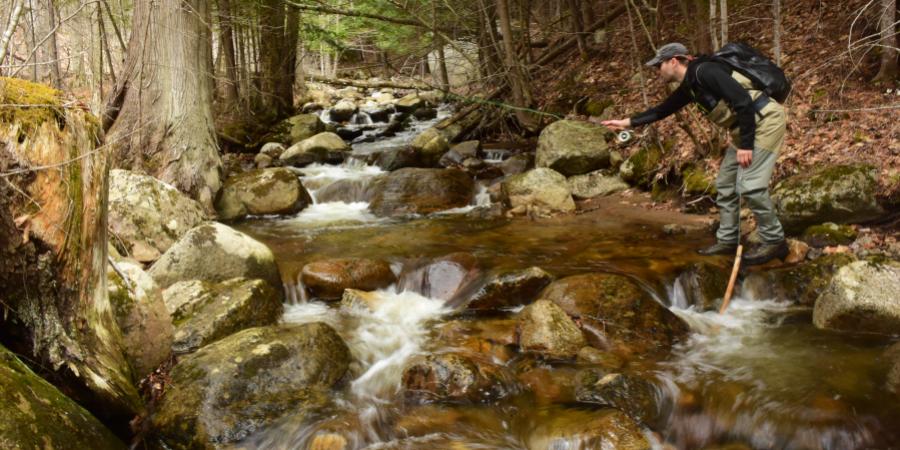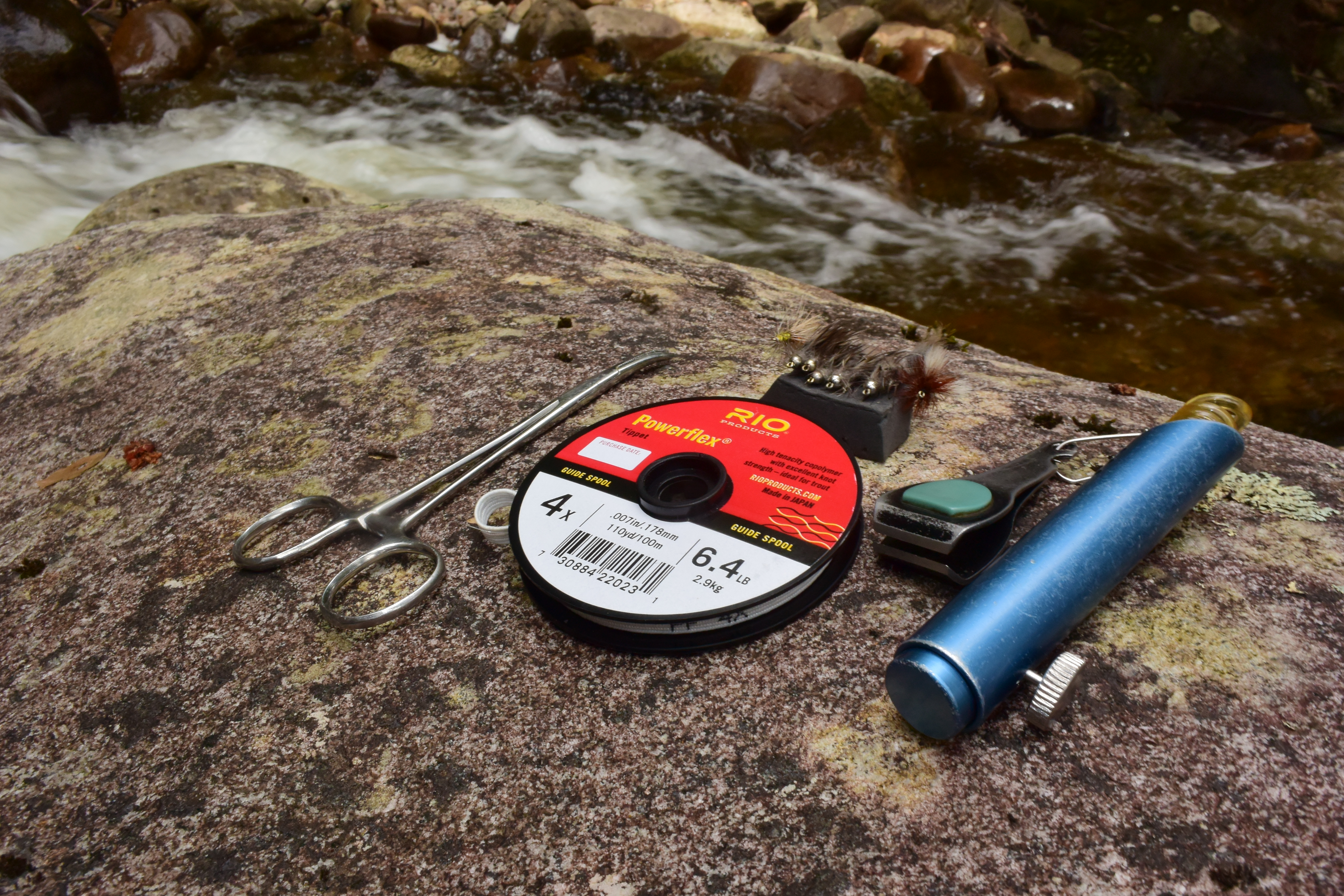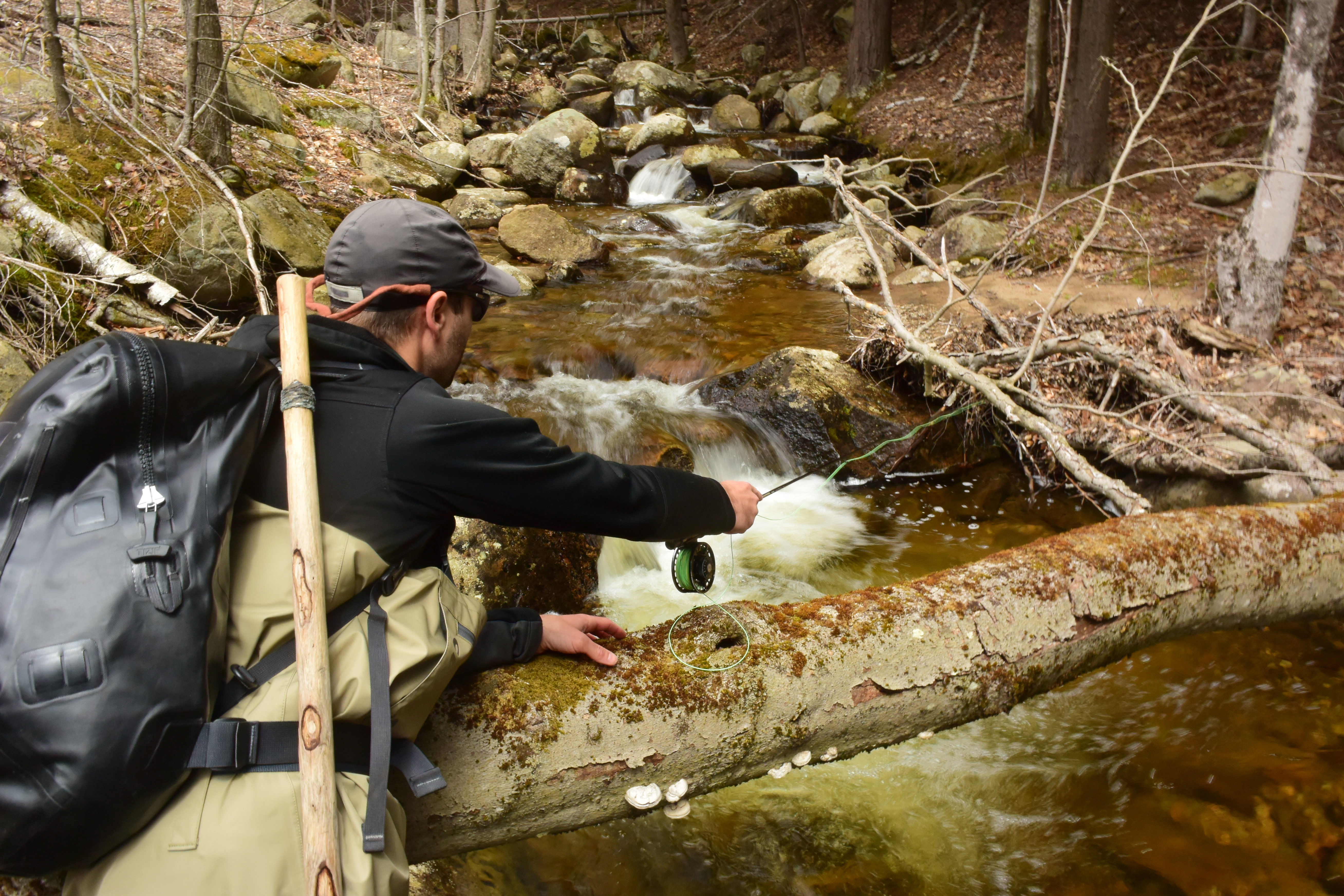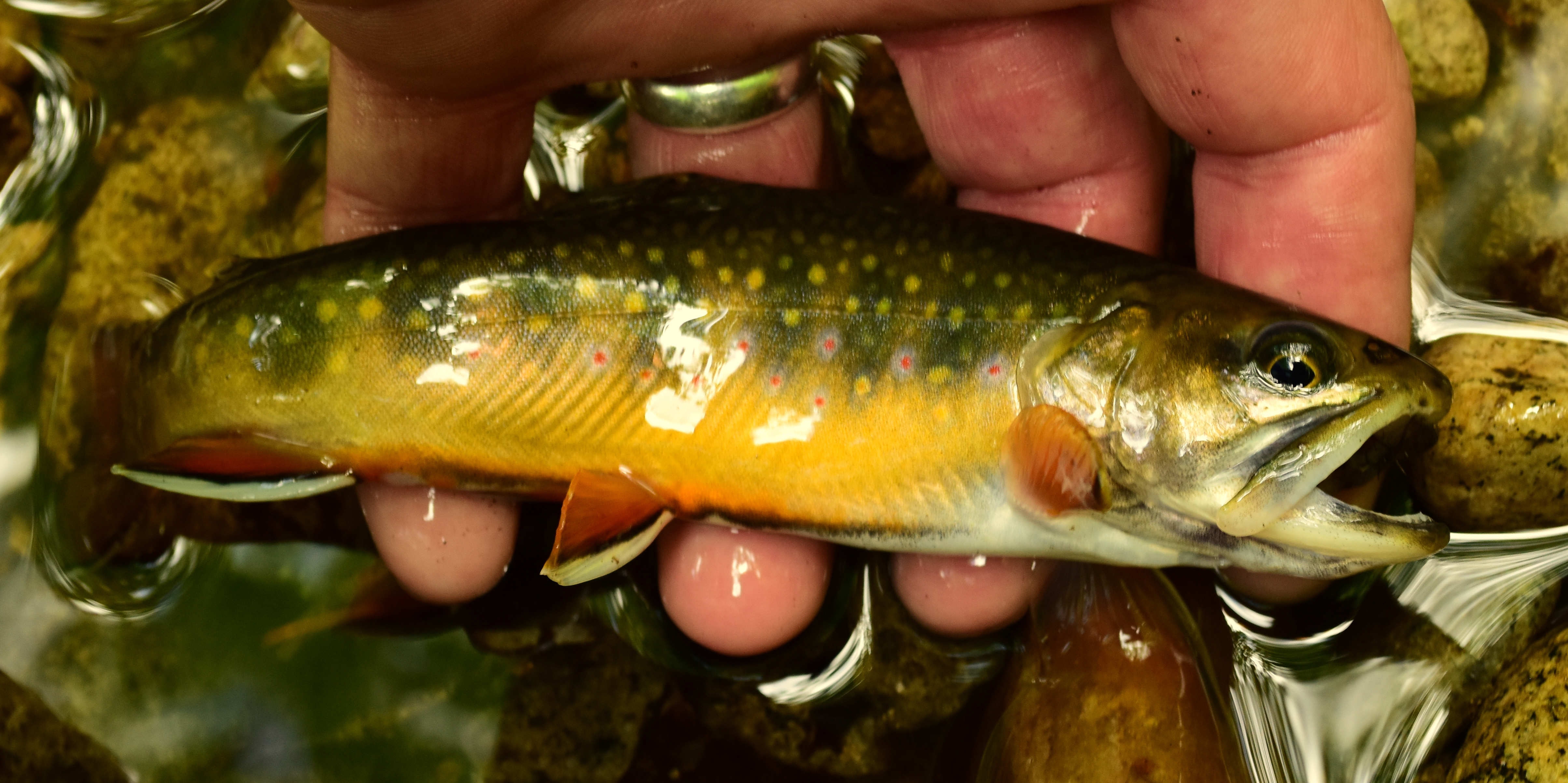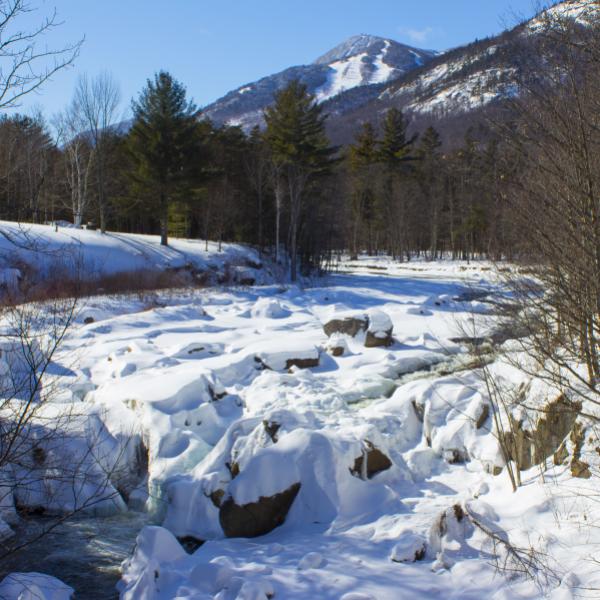Many anglers know that Adirondack summer months are not the ideal time for trout fishing in larger rivers. As the weather warms, so does the water. Water temperatures in the upper 60s and above cause stress for all trout species, and temperatures above 70 °F can be lethal for brook trout. The Ausable River Association (AsRA) has over 20 temperature loggers deployed year-round throughout the watershed, and NYDEC and TU have others. Data from these loggers show that the water temperatures in the East Branch and West Branch Ausable Rivers can frequently climb into the upper 70s in July, August, and early September, and in lower sections sometimes even approach 80 °F. Once water temperatures start reaching the upper 60s and above, most anglers consider it unethical to pursue trout. So, what is the summer angler to do? One option is to fish for warmwater species, such as bass or perch. Another option, if you prefer to stick with trout, is to focus on small stream tributaries that feed the main stem of river systems. If your goal is help conserve the species you want to fish for years to come, this is the best alternative. Tributaries of the Ausable River are cooler than the main river since they are fed by multiple groundwater sources.
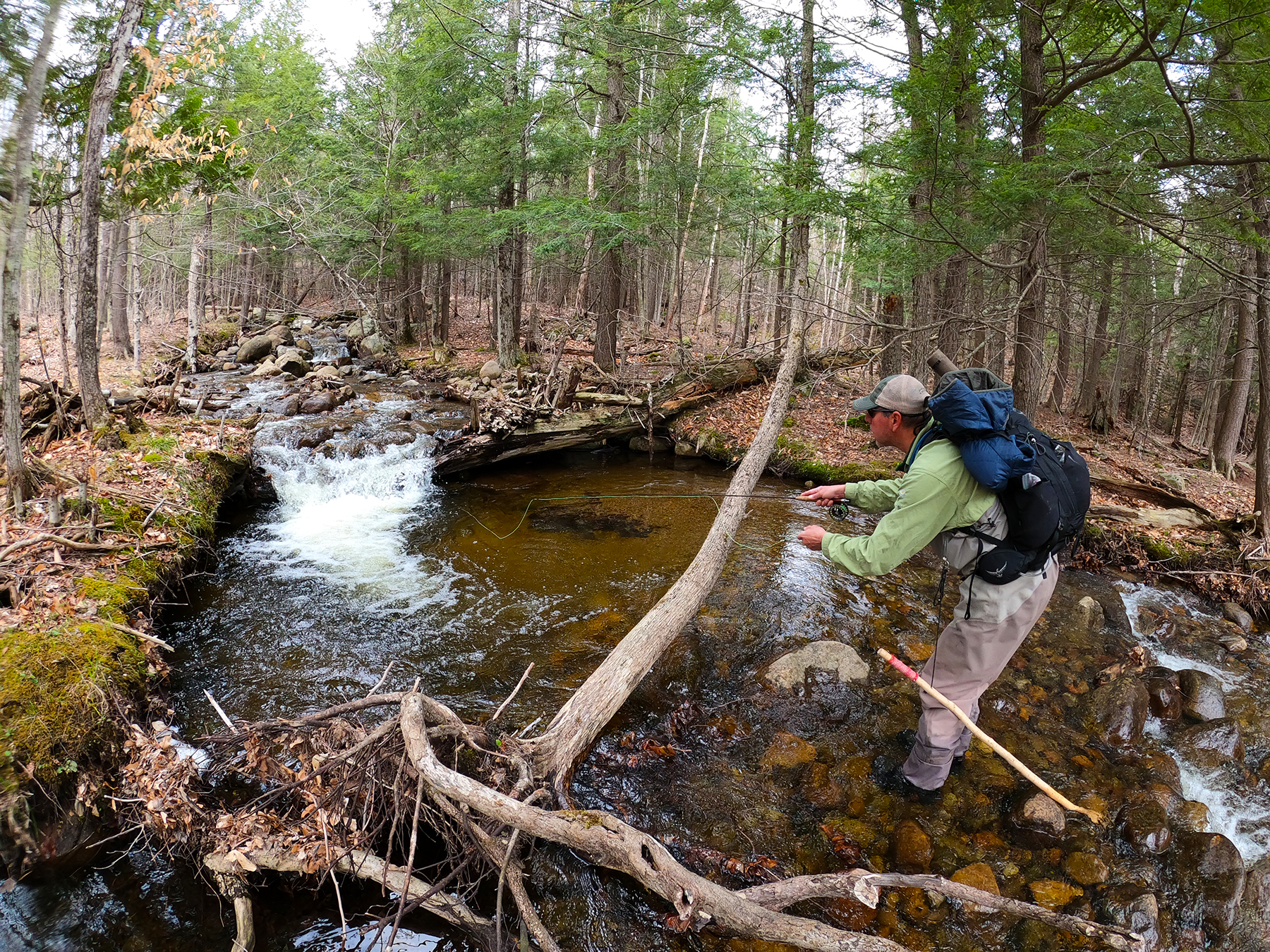
You may be surprised at just how many brook trout live in the biodiverse habitats of Ausable tributary streams.
With this information in mind, I spent a morning in early May (before our busy summer season) with Rich Garfield learning the finer points of fishing small Adirondack streams. When we arrived at the bank of a soothing Ausable tributary, I knew I was in for an informative treat. Rich began by explaining that the ideal fly-fishing rod for small stream tributaries are six to eight feet in length and rod weights of 1/2/3. This combination of length and weight are ideal for this type of fishing.
While talking, Rich seamlessly set up the fly rod for the small stream adventure ahead. As a fly-fishing novice, he gave me a refresher on some fly-fishing basics. For example, as he threaded the line through the guides, he explained the different parts of the leader: the butt is closest to the line, the intermediate falls in the middle, and the tippet is the very end part of the leader - this is the section of the leader system is where the fly is attached. It's ideal to use a leader no longer than 4 ft in length and with a tippet of 3x, as this allows for more control and less tangle. A 3x tippet allows for retrieval from branches, leaves, logs, rocks and any other potential snag, an experience bound to happen at some point as you navigate overhanging shrubs and downed trees. Rich reminded me that it's always a good idea to bring a spare spool of tippet, as you sometimes need to cut it in a dire tangle situation.
Minimal fly fishing gear is needed for fishing small tributary streams. Photo credit: Rich Garfield.
With the line and leader in place, we moved onto the fly pattern itself. For small tributary streams, there's no need to bring all your fly-fishing gear. A small fly box with both wet and dry patterns, nippers, forceps, dry fly dressing, split shot, and a spare tippet will do. On this day we were using a classic wet fly: the Ausable Ugly, a pattern created by Rich himself. With the fly securely tied to the tippet, Rich attached a BB size split shot and tied a blood knot (a type of jam knot) 2 inches above the fly to keep it from sliding down onto the fly. He added the finishing touch to the whole setup by using forceps to pinch the barb flat, creating a barbless hook that is less harmful for the fish. A quick clip of the excess tippet line with his chest-strung nippers secured by a retractable zinger, and we were ready to venture into the deep pools and cascading drops of the crystal-clear stream.
I have a lifetime fishing license in New York State, but typically use it for spin cast bass fishing. It's also been a few years since I've fly fished at all, and I needed a solid refresher on technique, especially on a minuscule brook. A teacher at heart, Rich described and demonstrated some of the casting methods he's perfected over the years. He explained that control of the fly pattern comes from the rod, not the line or leader, and showed me methods of properly presenting the fly to the water. You cannot use the iconic fly-casting techniques on small stream tributaries. This environment calls for a more subtle and nuanced casting style, one that focuses on precision over distance. One of the more impressive techniques, aptly called the "bow and arrow," involved holding the fly by the hook bend and using the flex of the rod to pull tension on the line and project the fly toward a precise spot on the stream, much like shooting an arrow from a long bow.
Half the fun of fishing small tributary streams is the challenge of navigating the many natural obstacles. Photo credit: Rich Garfield.
Along with casting technique, another critical aspect of fishing small tributaries is reading the water, or more specifically, forms and features of the stream channel and bed. Since fish are facing upstream into the current, we waded upstream to avoid alerting the fish. We also focused on walking in the water and on rocks so that we didn't trample riparian vegetation along the banks. When we spotted a deep pool, a log perched on the shoreline, or a rocky overhang, we tucked behind a boulder or in a calm downstream pool and cast toward the structure likely to hold a speckled brookie.
Support our water temperature monitoring efforts to understand where waters are warming and track the success of our stream restoration efforts. Give with confidence today!
Due to Rich's expert instruction, after only four or five casts I had a gorgeous brook trout on the line. It took me a while to achieve an accurate cast and gentle but firm tugging motion to set the hook without injuring the fish, but before long I was catching a brook trout on the first or second cast in almost every tranquil pool. With wet hands and placid fingers, we removed each fish from the hook, never needing to use the hook removal forceps that Rich carried on the trip. Each fish was out of the water for 10 seconds or less before it was gently returned to the pool from which it was caught.
All told we probably caught and released 20 or so fish that morning. It's hard to describe the excitement and satisfaction of catching brook trout after brook trout while knowing we were fishing in as ethically a manner as possible. When were we satisfied with the day, we drove back to home base where we checked, cleaned, and dried our wading equipment and reviewed our photos and videos from the morning.
There are few freshwater fish as beautiful as the brook trout. Photo credit: Rich Garfield.
Norman Maclean, in his classic semi-autobiographical novella A River Runs Through It, summarized time in terms of angling. "Poets talk about 'spots of time,' but it is really fishermen who experience eternity compressed into a moment. No one can tell what a spot of time is until suddenly the whole world is a fish and the fish is gone." It may be melodramatic or overly romantic to connect this idea of time with climate change, but in many ways the two are inseparable. Climate change is warming our waters, and we don't know what the future of our native trout species will look like. My day of fishing in our cool tributaries made the urgency of our programs at AsRA apparent to me in a new way.
I spend much of my work life doing my best to help AsRA achieve our goals. Among this work is promoting our brook trout conservation efforts, such as water temperature monitoring, river and stream restoration for habitat connectivity, environmental DNA mapping, and riparian tree planting in an effort to protect against threats imposed by climate change. As a non-science staffer, however, one of the AsRA goals closest to my heart is engaging our communities in responsible, low-impact recreational activities. It's always a pleasure when I get to partake in these same activities myself. I hope that you and your fellow anglers feel inspired to spend some of the warmer days this summer exploring the small tributaries that support our native bookies. In so doing, you're also protecting these native species and ensuring that they, and future generations of anglers, will enjoy the magnificent waters of the Ausable River watershed for years to come.
Check out this video of brook trout being released back into a cold Ausable tributary stream!
Story by Tyler Merriam, Donor Outreach Manager. Top photo credit: Rich Garfield.
Sign-up for our e-newsletter to get weekly updates on the latest stories from the Ausable River Association.
